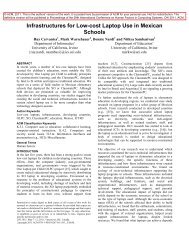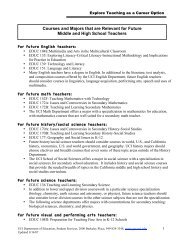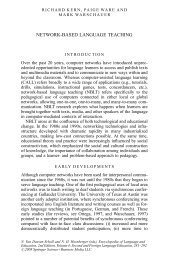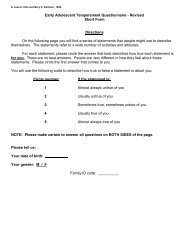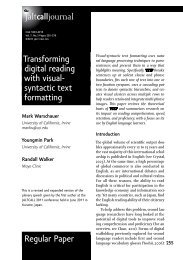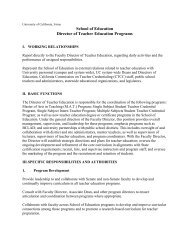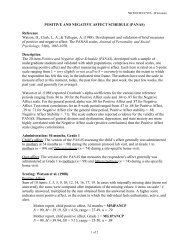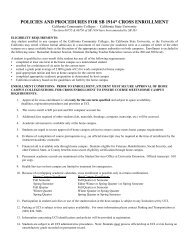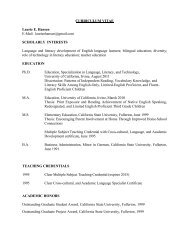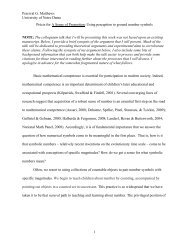Social Studies to Elementary Level ELLs - Department of Education
Social Studies to Elementary Level ELLs - Department of Education
Social Studies to Elementary Level ELLs - Department of Education
Create successful ePaper yourself
Turn your PDF publications into a flip-book with our unique Google optimized e-Paper software.
Strategies for Teaching<br />
<strong>Social</strong> <strong>Studies</strong><br />
<strong>to</strong> <strong>Elementary</strong> <strong>Level</strong> <strong>ELLs</strong><br />
Evelyn Marino Weisman and Laurie E. Hansen<br />
From The <strong>Social</strong> <strong>Studies</strong><br />
encountering students who<br />
CROSS are in the U.S., process teachers <strong>of</strong> learning<br />
English as a second language. In<br />
are<br />
the past two decades, this student<br />
population, known as English-languagelearners<br />
(<strong>ELLs</strong>), has morethan<br />
doubled. Because <strong>of</strong> the linguistic<br />
demands <strong>of</strong> social studies content,<br />
<strong>ELLs</strong> may have particular difficulty<br />
understanding this subject area.<br />
At the same time, federal and state<br />
governments are calling for all students,<br />
including<strong>ELLs</strong>,<strong>to</strong> demonstrate<br />
pr<strong>of</strong>iciency on state tests. Teachers<br />
are faced with the challenge <strong>of</strong> finding<br />
ways <strong>to</strong> help <strong>ELLs</strong> learn content<br />
that is presented <strong>to</strong> them entirely in<br />
English, a language they are struggling<br />
<strong>to</strong> master.<br />
<strong>Social</strong> studies may be the most<br />
difficult subject for <strong>ELLs</strong>. Unlike subjects<br />
such as math or science, understanding<br />
social studies concepts<br />
depends <strong>to</strong> a large extent on language<br />
skills.<br />
Helping <strong>ELLs</strong> Succeed<br />
Understanding subject matter<br />
while acquiring English-language<br />
skills requires adaptations <strong>to</strong> instruction.<br />
Sheltered instruction, or<br />
specially designed academic instruction<br />
in English, uses techniques <strong>to</strong><br />
make content accessible <strong>to</strong> <strong>ELLs</strong> or<br />
makes language and concepts visible.<br />
The purpose <strong>of</strong> sheltered instruction<br />
is tw<strong>of</strong>old: (1) <strong>to</strong> teach<br />
content and (2) <strong>to</strong> teach academic<br />
language.<br />
Evelyn Marino Weisman is associate pr<strong>of</strong>essor and Laurie E. Hansen is a<br />
lecturer, both in the <strong>Department</strong> <strong>of</strong> <strong>Elementary</strong> and Bilingual <strong>Education</strong> at<br />
California State University, Fuller<strong>to</strong>n. Condensed from The <strong>Social</strong> <strong>Studies</strong>, 98<br />
(September/Oc<strong>to</strong>ber 2007), 180-184, with permission <strong>of</strong> the Helen Dwight<br />
Reid <strong>Education</strong>al Foundation. Published by Heldref Publications, 1319 Eighteenth<br />
St., NW. Washing<strong>to</strong>n, DC 20036-1802. Copyright © 2007.<br />
December 2007 61
THE EDUCATION DIGEST<br />
The sheltered approach includes<br />
many strategies, such as teachers<br />
speaking clearly, emphasizing and<br />
repeating key points, defining vocabulary<br />
in context, and coupling<br />
talk with gestures, drawings,<br />
graphs, and charts. The aim is <strong>to</strong><br />
provide appropriate scaffolding, or<br />
contextual support, <strong>to</strong> ensure content<br />
is comprehensible. In addition,<br />
effective sheltered instruction provides<br />
opportunities for social interaction<br />
<strong>to</strong> reinforce learning and<br />
promote the production <strong>of</strong> language,<br />
including content-specific<br />
terms.<br />
Background Knowledge<br />
Students learning English may<br />
lack background knowledge in social<br />
studies <strong>to</strong>pics. Some may not<br />
have had formal schooling in their<br />
home countries and, consequently,<br />
may not be familiar with concepts<br />
about geography, his<strong>to</strong>ry, or government<br />
even as they relate <strong>to</strong> their<br />
native countries. Another problem<br />
is student's background knowledge,<br />
or "funds <strong>of</strong> knowledge," may not<br />
be valued by the school. For example,<br />
<strong>ELLs</strong> may have extensive<br />
knowledge <strong>of</strong> their culture, but it is<br />
<strong>of</strong>ten ignored as a potential resource<br />
because many teachers are<br />
unfamiliar with their student's culture<br />
and how <strong>to</strong> bring it in<strong>to</strong> the<br />
curriculum. Following is an example<br />
<strong>of</strong> how a teacher can build on <strong>ELLs</strong>'<br />
prior knowledge and connect new<br />
information with their own experiences<br />
<strong>to</strong> make it more meaningful.<br />
Vignette 1: Anna, a fifth-grade<br />
teacher, begins asocial studies unit<br />
on immigration and migration in<br />
the U.S. by reading Grandfather's<br />
Journey <strong>to</strong> the class. This s<strong>to</strong>ry describes<br />
a Japanese man's journey<br />
<strong>to</strong> America. After reading the s<strong>to</strong>ry,<br />
Anna opens a satchel full <strong>of</strong> items<br />
representative <strong>of</strong> thosethat her own<br />
grandfather brought when he came<br />
<strong>to</strong> the United States from Denmark.<br />
Anna explains the reasons her<br />
grandfather left his native country<br />
and shows students his travel route<br />
on amap.AsAnnashows theitems,<br />
she talks about each one, recalling<br />
events from her grandfather's journey<br />
<strong>to</strong> America through Ellis Island<br />
in the early 1900s. Items include a<br />
comb, a shaving kit, some Danish<br />
money, a <strong>to</strong>othbrush, and a pho<strong>to</strong>graph<br />
<strong>of</strong> loved ones back home.<br />
Anna then asks students <strong>to</strong> think<br />
about why people leave their homeland<br />
and what items they would<br />
bring with them. Some students<br />
have journeyed from other countries<br />
<strong>to</strong> America. Others have not<br />
but can imagine what would be<br />
needed in these circumstances. For<br />
homework, she asks them <strong>to</strong> interview<br />
a family member about their<br />
journey or one <strong>of</strong> past generations,<br />
draw it on a map, and bring some<br />
items that relate <strong>to</strong> that journey.<br />
The next day, students talk about<br />
what they brought and why the<br />
items are meaningful. The class then<br />
discusses fac<strong>to</strong>rs that contribute<br />
<strong>to</strong> people moving from one place <strong>to</strong><br />
another.<br />
62<br />
www.eddigest.com
Strategies for Teaching <strong>Social</strong> <strong>Studies</strong> <strong>to</strong> <strong>ELLs</strong><br />
In this vignette, the concepts and<br />
causes for immigration and migration<br />
are introduced through a book<br />
and expanded on by the teacher's<br />
personal family his<strong>to</strong>ry. The teacher<br />
uses realia, or real objects, <strong>to</strong> add<br />
interest and help convey meaning.<br />
The use <strong>of</strong> real objects, charts, pictures,<br />
or pho<strong>to</strong>graphs is an essential<br />
feature <strong>of</strong> effective instruction<br />
for <strong>ELLs</strong> because they provide a<br />
necessary support <strong>to</strong> construct<br />
meaning.<br />
In addition, asking students <strong>to</strong><br />
bring objects, pho<strong>to</strong>s, or drawings<br />
related <strong>to</strong> their own family s<strong>to</strong>ries<br />
<strong>of</strong> immigration provides an explicit<br />
link with their background knowledge,<br />
which will help them understand<br />
the upcoming lessons about<br />
immigration and settlement patterns<br />
<strong>of</strong> American people.<br />
Obtaining insight in<strong>to</strong> students'<br />
backgrounds can be valuable <strong>to</strong> understanding<br />
cultural and social fac<strong>to</strong>rs;<br />
however, many social studies<br />
concepts pose a challenge for making<br />
connections that facilitate learning.<br />
In such cases, the teacher may<br />
use role play as a means <strong>of</strong> constructing<br />
the schemata or background<br />
knowledge. For example,<br />
students can play the roles <strong>of</strong> colonists,<br />
the king <strong>of</strong> England, and the<br />
king's representative <strong>to</strong> dramatize<br />
the concept <strong>of</strong> taxation without representation<br />
and how it led <strong>to</strong> increasing<br />
conflict between the<br />
American colonies and Great Britain.<br />
Acting out situations can facilitate<br />
comprehension <strong>of</strong> difficult concepts<br />
by making them more concrete.<br />
It also stimulates interest,<br />
provides opportunities for discussing<br />
different perspectives, and engages<br />
students in language practice.<br />
Making Content<br />
Comprehensible<br />
Students may quickly acquire<br />
conversational skills, but it may take<br />
longer for them <strong>to</strong> develop literacy<br />
skills and academic language. Academic<br />
language is the abstract language<br />
used for instruction that typically<br />
has no context clues <strong>to</strong> support<br />
meaning. Graphic organizers,<br />
such as Venn diagrams, series <strong>of</strong><br />
events chains, compare and contrast<br />
matrixes, and T-charts help<br />
students construct meaning from<br />
text and understand the relationships<br />
between ideas.<br />
Along with comprehensible input,<br />
researchers suggest that interaction<br />
with others and language<br />
output is just as important <strong>to</strong> language<br />
development. When students<br />
read, create timelines, or write and<br />
present reports, they are practicing<br />
literacy skills that are essential<br />
for academic success. The following<br />
vignette <strong>of</strong>fers ideas for integrating<br />
language activities in<strong>to</strong> content<br />
instruction <strong>to</strong> develop subjectmatter<br />
knowledge and language<br />
skills.<br />
Vignette 2: Jos6, a fourth-grade<br />
teacher, is teaching a unit on Native<br />
Americans. Students are learning<br />
December 2007 63
THE EDUCATION DIGEST<br />
about different Native American<br />
tribes that lived in regions throughout<br />
the U.S. In addition <strong>to</strong> the textbook,<br />
Jos6 uses pictures, Native<br />
American literature, his<strong>to</strong>rical<br />
documents, and oral his<strong>to</strong>ries <strong>to</strong><br />
convey concepts. During the unit,<br />
Jos6 asks students <strong>to</strong> work in groups<br />
<strong>to</strong> review the information theyhave<br />
learned and compare NativeAmerican<br />
tribes. In each group <strong>of</strong> four <strong>to</strong><br />
five students, there are <strong>ELLs</strong> and<br />
native English speakers.<br />
Each group creates a chart comparing<br />
characteristics <strong>of</strong> Native<br />
American life, such as housing, climate,<br />
<strong>to</strong>ols, food sources, and traditions<br />
<strong>of</strong> Native Americans from<br />
regions such as the Southwest,<br />
Northwest, Great Plains, and<br />
Northeast.The charts are posted in<br />
the classroom and serveas aspringboard<br />
for discussion about similarities<br />
and differences among the<br />
tribes and the range <strong>of</strong> perspectives<br />
<strong>of</strong>fered by different sources <strong>of</strong><br />
information. Throughout the discussion,<br />
Jos6 paraphrases and expands<br />
on students' ideas and writes<br />
them on the board for the class <strong>to</strong><br />
read aloud. Last, Jos6 asks the students<br />
<strong>to</strong> write a summary <strong>of</strong> what<br />
they have learned.<br />
In this example, students use a<br />
graphic organizer, or process grid,<br />
<strong>to</strong> categorize information about<br />
Native American tribes. Displaying<br />
and organizing the information lets<br />
students easily see relationships<br />
among concepts. In this vignette,<br />
students worked <strong>to</strong>gether <strong>to</strong> com-<br />
plete the grid and share information,<br />
thereby integrating the learning<br />
<strong>of</strong> content with practice in using<br />
academic language. Ideally,<br />
groups should consist <strong>of</strong> a variety<br />
<strong>of</strong> learning and language levels so<br />
students can support and learn from<br />
one another. Working in small<br />
groups generallyfosters alow-anxiety<br />
atmosphere, which is particularly<br />
important <strong>to</strong> second-language<br />
acquisition. Keep in mind the different<br />
English-language pr<strong>of</strong>iciency<br />
levels <strong>of</strong> students and adjust expectations<br />
and questions accordingly.<br />
By paraphrasing, elaborating on<br />
key concepts, writing these on the<br />
board, and engaging students in<br />
reading and writing, the teacher<br />
models oral and written forms <strong>of</strong><br />
academic language and provides<br />
practice with sentence structures<br />
and skills that enable students <strong>to</strong><br />
communicate complex ideas. As<br />
students discuss and compare information<br />
gleaned from a variety <strong>of</strong><br />
sources, they develop an understanding<br />
<strong>of</strong> how cultural biases and<br />
values can influence knowledge<br />
construction.<br />
Vocabulary a Challenge<br />
Vocabulary development presents<br />
a special challenge for <strong>ELLs</strong>.<br />
Many words have dual meanings.<br />
For example, the term inflation<br />
means <strong>to</strong> fill, as with air in a balloon,<br />
but in economics, it means a<br />
rise in the general price level.Other<br />
terms, such as taxation and liberty,<br />
represent complex ideas that re-<br />
64 w .ed digest.com
Strategies for Teaching <strong>Social</strong> <strong>Studies</strong> <strong>to</strong> <strong>ELLs</strong><br />
quire concrete examples <strong>to</strong> develop<br />
understanding. In the following vignette,<br />
a teacher develops vocabulary<br />
knowledge through an engaging<br />
activity.<br />
Vignette 3: Alicia teaches sixth<br />
grade. At least one-third <strong>of</strong> her students<br />
are <strong>ELLs</strong> who need additional<br />
support. When teaching a unit on<br />
Ancient Egypt, there are many vocabularywords<br />
such as hieroglyphics,<br />
irrigation, car<strong>to</strong>uche, pyramid,<br />
pharaoh, sarcophagus, and mummification.<br />
Rather than teaching all<br />
the vocabulary at once, she introduces<br />
the vocabulary for each lesson<br />
as she teaches it.<br />
Alicia makes extensive use <strong>of</strong><br />
pictures and realia <strong>to</strong> teach five or<br />
sixwords per lesson. She writes the<br />
words onaword wall, explains their<br />
meanings, provides examples, and<br />
draws pictures <strong>to</strong> help convey<br />
meaning. She asks students <strong>to</strong> use<br />
the words in sentences and share<br />
these with partners. The words remain<br />
on the word wall throughout<br />
the unit, and Alicia refers <strong>to</strong> them<br />
<strong>of</strong>ten. Students collect vocabulary<br />
words as they progress through<br />
the unit, writing a definition for each<br />
in their own words and drawing a<br />
corresponding picture.<br />
Students also record words they<br />
do not understand as they encounter<br />
them. These words are then<br />
discussed and added <strong>to</strong> student<br />
dictionaries. For review, Alicia asks<br />
the children <strong>to</strong> work in groups <strong>of</strong><br />
five or six <strong>to</strong> create definitions for a<br />
class Jeopardy game. Students are<br />
given a list <strong>of</strong> vocabulary words<br />
and work <strong>to</strong>gether <strong>to</strong> write each<br />
definition on a separate overhead<br />
transparency sheet. When playing<br />
the game, each team sends a representative<br />
<strong>to</strong> the front <strong>of</strong> the room <strong>to</strong><br />
display one definition (e.g., "the<br />
body <strong>of</strong> a person or animal that has<br />
been preserved"). The other teams<br />
try <strong>to</strong> figure out what vocabulary<br />
word each definition represents (in<br />
this case, "What is a mummy").<br />
In this example, the understanding<br />
<strong>of</strong> vocabulary is developed<br />
through (1) explicit instruction using<br />
visual aids <strong>to</strong> help convey meaning<br />
and (2) frequent repetition. In<br />
addition, reducing the number <strong>of</strong><br />
words presented at one time makes<br />
learning more manageable, and<br />
having students create their own<br />
dictionaries provides a valuable<br />
personal resource.<br />
Last, engaging students in a game<br />
is an excellent way <strong>to</strong> reinforce vocabulary<br />
knowledge. In this example,<br />
students talked with one another<br />
<strong>to</strong> develop definitions and<br />
match definitions with key terms.<br />
Conclusion<br />
In these vignettes, <strong>ELLs</strong> are actively<br />
engaged in understanding<br />
content and acquisition <strong>of</strong> language<br />
skills. By providing <strong>ELLs</strong> with appropriate<br />
scaffolding, teachers can<br />
facilitate their learning a rigorous<br />
curriculum, develop their Englishlanguage<br />
skills, and promote their<br />
active participation in the classroom.<br />
(<strong>to</strong><br />
December 2007<br />
,65-
COPYRIGHT INFORMATION<br />
TITLE: Strategies for Teaching <strong>Social</strong> <strong>Studies</strong> <strong>to</strong> <strong>Elementary</strong><br />
<strong>Level</strong> <strong>ELLs</strong><br />
SOURCE: Educ Dig 73 no4 D 2007<br />
The magazine publisher is the copyright holder <strong>of</strong> this article and it<br />
is reproduced with permission. Further reproduction <strong>of</strong> this article in<br />
violation <strong>of</strong> the copyright is prohibited.



